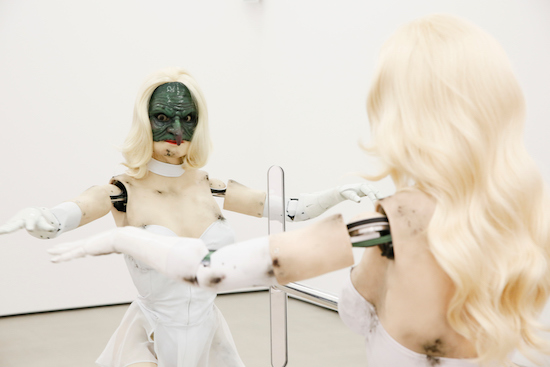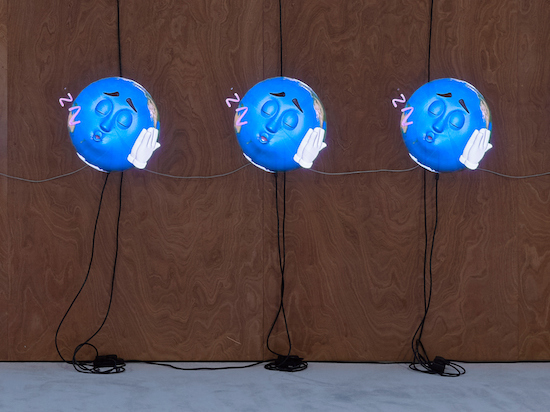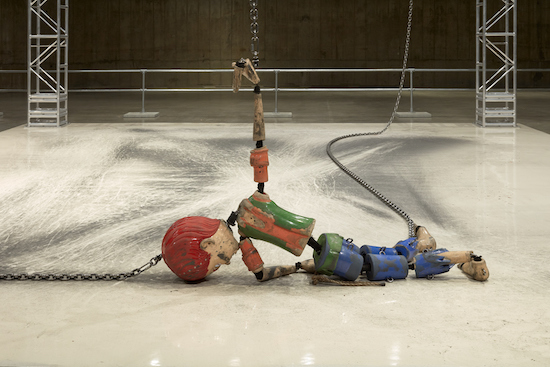Installation view, Jordan Wolfson, Colored sculpture, 2016, South Tank, Tate Modern, London, 03 May – 31 August 2018 Credit: © Jordan Wolfson, courtesy Sadie Coles HQ, London. Photo: Robert Glowacki
It took weeks to get in touch with the artist Jordan Wolfson. Initially, there was a press blackout that I had to respect. When the blackout was lifted, I was scheduled to interview Wolfson over Skype. That interview was then pushed back at the last minute to the following week, during which time I was asked to agree to a set of demands: quote approval, certain questions off the table, etc. On the day the interview was rescheduled for, Wolfson cancelled it all together, preferring to write out his responses over email. When I agreed, Wolfson sent his responses rather quickly. The answers he sent were slightly dismissive and vaguely hostile, but insightful nonetheless. They are also exactly the kind of direct and subtly aggro responses you’d want to get from an artist like Wolfson. Wolfson has clearly grown tired of critics pretending they know more about his work than he does.
Of course, Wolfson has some reason to be cagey about the press right now. Recently, The New Yorker published an article by writer Dana Goodyear entitled Jordan Wolfson’s Edgelord Art. The article is framed as a hit piece, delving into Wolfson’s perceived bad behavior, his artistic transgressions as “expressions of privilege,” and his alleged arrogance, in efforts to depict an artist of imperfect moral fiber. The artist Mathieu Malouf, who used to work as an assistant to Wolfson, recently pointed out to me that there’s an effort to de-problematise art history by defusing the “edge-lordiness” of the heroes of the avant-garde.
People seem to forget that the “enfant terrible” is a well-worn trope of art and literary history and perfectly valid as an artistic position. Art history is full of provocations: Gustave Courbet’s Origin of the World, Pablo Picasso’s Les Demoiselles d’Avignon, and Duchamp’s Fountain all enraged countless normies during their times. What is unique to the contemporary art world is that it’s often artists telling other artists what they should or should not be interested in. Censorship is emerging from within the ranks of the art world itself. “Most artists, curators, and writers seem to have decided that their true calling is to be the upholders of moral decency,” wrote Dean Kissick in his Spike Magazine column last summer. “Nobody has asked them to do this, but they’re doing it anyway; perhaps because they have no other recourse through which to address social ills; perhaps because virtue-signalling and shaming others is easy, and cathartic, and requires no accountability; or maybe because adopting a group mentality is a natural and understandable defence mechanism in difficult times.” Say what you want about Wolfson, but no one can justly accuse him of virtue-signalling or adopting groupthink.
Goodyear’s article is largely wrong-headed and histrionic. For one, it tastelessly excavates Wolfson’s romantic history, harping on what could be perceived as nothing short of anti-Semitic stereotypes in its portrayal of Wolfson as something akin to a Phillip Roth-esque “horny jew.” The article also seems to suggest that “naughty artists” are somehow more evil than the financial backers of the art world itself, that those who express themselves freely are more dangerous than those who launder their blood money through the purchasing of art objects.
Artist Brad Troemel – whose Instagram page has become a refuge for artists and writers alienated by the centre-left neoliberal stance of most arts media and associated with what we Americans have dubbed “the dirtbag left” but you Brits would probably just call the materialist/Marxist left – wrote about the article on his Instagram stories: “It should alarm you that the same article is rewritten word for word every six months as a sacrificial offering to the gods so art media can morally absolve itself from its directly dependent relationship on some of the most reprehensible wealth criminals alive,” wrote Troemel. “They’ll have you believe a sculpture that twerks is worse than an actual owner of a private prison or a private healthcare executive who profits on death.”

Installation view, Jordan Wolfson, (Female figure), 2014, The Broad, Los Angeles, 11 October 2018 – 20 January 2019 Credit: © Jordan Wolfson, courtesy The Broad, Los Angeles and Sadie Coles HQ, London. Photo: Ryan Miller/Capture Imaging
Wolfson’s public persona is, as it is for most artists, part of his work (that dreadful Goodyear article made the surprisingly accurate observation that Wolfson’s most uncensored and “troublesome” performance is that of himself). Transgression is his subject matter, and articles framing him as an “edgelord,” or someone who deliberately exploits taboo subject matter to shock viewers, only reinforce the power of his work. The less that neoliberal press outlets like The New Yorker attempt to understand his art in terms of cultural or historical importance, the more interesting that the work actually becomes. For a 2016 interview with curator Beatrix Ruf published by Kaleidoscope Magazine, Wolfson appeared in a series of portraits by photographer Jason Nocito as a Patrick Bateman of the art world. Wolfson is shirtless, hair slicked back with a thick application of pomade, removing a dermatological face mask, basking in male narcissism and egocentrism.
The connections are obvious: when Bret Easton Ellis first finished American Psycho in 1991, the fallout was immediate. He was dropped by his publisher Simon and Schuster and became the scourge of Gloria Steinem feminists and literary critics alike. It was only later, after the novel had been adapted into a film by feminist filmmaker Mary Harron and became a mainstay of contemporary literature courses the world over, that the importance of the novel came into focus. American Psycho isn’t just revered for its “edgelordy” over-the-top violence and shock value, but for its significant formal and stylistic innovations and transgressions. Ellis pioneered a new stream-of-consciousness storytelling in which he totally merged with the psyche of the protagonist that he dreamed – or “nightmared” – into existence. “The miracle of Bret Easton Ellis is that without a plot, without much in the way of characters and with a throwaway nonstyle that renders the luxurious, the erotic and the grotesque in the same uninflected drone, a prose that is pure exchange value, he nevertheless makes it virtually impossible to stop reading,” wrote Henry Bean for the Los Angeles Times in what would be the one positive contemporaneous review of the book.
Wolfson is likewise fascinated by transgression. Part of that fascinations comes from the ability to shock an audience, yes, but even more important to him is formal transgression. Wolfson wants to create artistic languages that have never been used and make art that the world has never seen before. Like Duchamp or Beuys or any of the decidedly “edgelord” heroes of the twentieth-century avant-garde that preceded him, he wants to expand upon the very notion of what constitutes an artwork within our culture. His work demands that the audience re-conceptualise their understanding of what “transgression” is. “I’m talking about formal transgression and transgression in content, but they are both the same,” writes Wolfson. “It doesn’t matter. Transgression creates a distortion and distortion creates a portal to the viewer’s return to self. Suddenly they observe observing and the world becomes strange and charged and the object they stand before becomes activated and new.”
In liquid modernity, culture has essentially become undead. It’s a zombie, endlessly repeating the same behaviours and mindlessly cannibalising any shred of originality that might come to the fore. According to Wolfson, transgression can reanimate culture. It can bring art back to life. It can reinvigorate the artwork with power and singularity. Wolfson’s best known projects all employ simultaneous formal subversions and thematic provocations. His work can leave you feeling troubled and alienated even as you are awe-stricken by its undeniable uniqueness.
But Wolfson doesn’t see his art as making any overt attempt to elicit any reaction from an audience. “My work for me, in the experience of making it and completing it, has always been based on myself as the first viewer and therefore what you see is the essence of how I see or how I desire to be seen by the artworks.” From this perspective, any discomfort a viewer might feel with Wolfson’s work is a discomfort with plumbing the psyche of someone outside themselves. Wolfson manipulates and reveals all at once: are we looking at him or at him as he wants to be seen? This is art as outgrowth of the conscious and unconscious minds, lascivious desires and all.

Installation view, Jordan Wolfson, ARTISTS FRIENDS RACISTS, Sadie Coles HQ, London, 31 January – 29 February 2020. Image credit: © Jordan Wolfson, courtesy Sadie Coles HQ, London. Photography: Jack Hems
In a 2011 animated video piece, Animation, masks, a stereotypical “Shylock” character flips through style magazines while a voiceover recorded by Wolfson and an unnamed female collaborator engaging in lurid and libidinal pillow-talk is audible as the piece’s audio: “Well your cock is a lot bigger than you say it is,” muses the woman. The Shylock character was developed based on Google Image results that came back when Wolfson searched “evil jew,” and the piece all but begs the audience to call Wolfson – a Jewish artist – an anti-Semite. But it was also undeniably radical for a contemporary artist to use animation in such a way at the time. Very few artists were applying these kinds of narratives to animated videos.
Wolfson’s animatronic sculptures are the pieces that he is perhaps best known for now. 2014’s (Female Figure) is a woman straight out of a nineties porn film – bleach blonde hair and clothed in a skimpy white article of lingerie – but subverted by the monstrous upper half of her face: part woman, part demon, all robot. She dances in front of a mirror singing along to a plethora of pop songs, like she’s getting in touch with an emergent sexuality or coming to terms with the nature of her being. 2016’s Colored sculpture features a disturbing ventriloquist dummy with illuminated demonic blue eyes suspended from the ceiling by chains. The dummy alternates between staring at the audience, dancing, and colliding into the ground enduring all manner of self-inflicted brutality and bodily harm. Wolfson used animatronics to pioneer a new performance art in which he used the implicit power dynamics of puppetry to yield a performer without agency. A performer totally at the mercy of an unseen creator. “Even movements that are not intrinsically violent suggest manipulation by a larger, invisible figure – a child dragging a doll, or an adult manhandling a real child,” says writer Patrick Flannery. “And the abuse takes its toll: the work exists in a state of ongoing destruction, its bright colours wearing away to reveal the matte grey body beneath.”
Wolfson’s now-infamous virtual reality piece Real Violence, which debuted at the Whitney Biennial in 2017, was only watchable through the viewer’s application of VR goggles. With the headset on, the viewer had no choice but to succumb to the bystander effect as we witnessed Wolfson over the course of two minutes savagely beat a man to death (actually a dummy). Wolfson manifestly rejects notions that violence in art isn’t compelling, and he infamously said the piece was “real violence, not a simulation.”
“Violence is everyone,” says Wolfson. “It’s inescapable. Just go online, turn on the TV, or observe your waking self, then observe your unconscious self and record your dreams.”

Installation view, Jordan Wolfson, ARTISTS FRIENDS RACISTS, Sadie Coles HQ, London, 31 January – 29 February 2020. Image credit: © Jordan Wolfson, courtesy Sadie Coles HQ, London. Photography: Jack Hems
All of Wolfson’s work wields the power of the new: new mediums, new technologies, new ideas. Not even the artist’s biggest detractors can take that away from him. Wolfson generates a symbiotic relationship between the different transgressions in his work: the provocative content would ring hollow without the sophisticated and original formal presentations of the work, and the unique presentation would be less powerful without those provocative statements.
Wolfson’s most recent show, ARTISTS RACISTS FRIENDS, was shown at Sadie Coles HQ gallery in London from January 31 to February 29. Despite its provocative title, Wolfson didn’t intend to make any commentary on ‘political correctness’ in the art world or specific manifestations of that political correctness; he wasn’t referring to the cancellation of the Darja Bajagić and Boyd Rice exhibition at Greenspon Gallery in 2018, the controversy surrounding a Dana Schutz painting of Emmett Till at that same Biennial that his VR piece was shown, or any of the high profile recent cases of artist-on-artist censorship. Instead, he was trying to signal to the audience to open themselves up to different and perhaps repressed aspects of their own psyches. “I wanted everyone to be open about the parts of them that were racists of the parts of them that were friends or the parts of them that were artists,” he says.
The installation uses a 3D holographic system called HYPERVSN that is most often used for eye-grabbing installations at trade fair booths. Wolfson uses the technology to annihilate the defences of the viewer, projecting images right onto them: a Star of David grows arms and lugs itself around the screens before unzipping itself and revealing an affectionate heart that gestures towards the audience. “It’s like a parody of virtue signalling in which the artist is literally flexing his Jewish identity,” wrote Hettie Judah for The Guardian.
In addition to the main piece, there are brass ovals each emblazoned with childhood photos of Wolfson himself, almost like he’s inviting the audience to ponder how such a sweet kid grew into such a maniacal, devilish adult man. Just as every great artist is in touch with his inner child, so is every prolific murderer, the assemblage suggests, with the photos looking like the family photos used in true crime docs to emphasise how allegedly normal the killer was as a child.
Here, the provocation is more suggested than it is overt, and the real transgression is more notably formal in this recent work. Walter Benjamin of course said that mass reproductions had depleted deplete artwork of aura, their “presence in time and space.” What Wolfson has achieved here is essentially a digital artwork – typically the most reproducible of art works – that largely can’t be reproduced. Its images move so dizzyingly fast that a camera can’t accurately freeze them in frame. This is a digital work brimming with presence. Typical to his nature however, Wolfson denies that this theoretical notion had anything to do with his conceptualisation of the piece. “I have simply an instinctive reaction to the medium,” he says. “There is something infinitely captivating and new to me about sculpture, i.e., physical space. I think the idea of sharing physical space with an object that reflects back onto your body is compelling.”
Wolfson is a necromancer of the art world. Culture has become a brain dead corpse drifting along a monotonous landscape. Nothing changes, nothing offends, nothing happens. By transgressing its creatively limiting taboos, by developing new forms with new mediums, Wolfson imbues the artworld with new life. He shapes it in his own image, and encourages all other artists to do the same. Looking at his brief and dismissive e-mail responses to my questions, it would be easy to write him off as just another rude, arrogant artist. But really what Wolfson is trying to achieve is to free art from the confines it’s trapped within in the post-digital hellscape that is late modernism. His answers are short because there aren’t any answers, really.
A great artist is almost always trying to express something that can’t be expressed in words. Art is something that should exist beyond the narrow discourses of New York media figures and their snob editors. It should exist beyond language itself. Wolfson is an undeniably contemporary artist, and this art is almost definitely in reaction to and a reflection of the world around him. But what separates Wolfson’s work from that of other artists is that it opens contemporary art to something beyond common understanding. To presence. At the risk of sounding corny, even to magic, maybe. “Artists are always free and should remember that,” he says. “I remind myself every day. When I allow myself to crumble in fear I feel physically sick, so that’s the alarm.”


